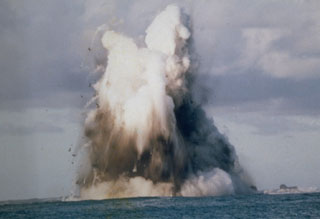Report on Nishinoshima (Japan) — 15 July-21 July 2020
Smithsonian Institution / US Geological Survey
Weekly Volcanic Activity Report, 15 July-21 July 2020
Managing Editor: Sally Sennert.
Please cite this report as:
Global Volcanism Program, 2020. Report on Nishinoshima (Japan) (Sennert, S, ed.). Weekly Volcanic Activity Report, 15 July-21 July 2020. Smithsonian Institution and US Geological Survey.
Nishinoshima
Japan
27.247°N, 140.874°E; summit elev. 100 m
All times are local (unless otherwise noted)
JMA scientists observed Nishinoshima from a ship on 11 July. They reported that a large amount of ash was emitted from the summit crater; plumes rose about 1.7 km and drifted W, dropping ash into the sea. Deposits of large blocks at the foot of the cone were visible. Lava fountains that rose 200 m above the crater were observable at night, along with lightning in the ash plumes. The cone had grown to about 200 m, about 40 m higher than an estimate on 1 December 2019. The report stated that ships should stay at least 2.5 km away from the cone.
Based on satellite data and pilot observations, the Tokyo VAAC reported that during 16-21 July ash plumes rose to 3.7-6.4 km (12,000-21,000 ft) a.s.l. and drifted N, NE, and E. Satellite data showed a sulfur dioxide plume reaching the western USA on 18 July, after traveling over 9,000 km from Nishinoshima.
Geological Summary. The small island of Nishinoshima was enlarged when several new islands coalesced during an eruption in 1973-74. Multiple eruptions that began in 2013 completely covered the previous exposed surface and continued to enlarge the island. The island is the summit of a massive submarine volcano that has prominent peaks to the S, W, and NE. The summit of the southern cone rises to within 214 m of the ocean surface 9 km SSE.
Sources: Japan Meteorological Agency (JMA), Tokyo Volcanic Ash Advisory Center (VAAC), Simon Carn

